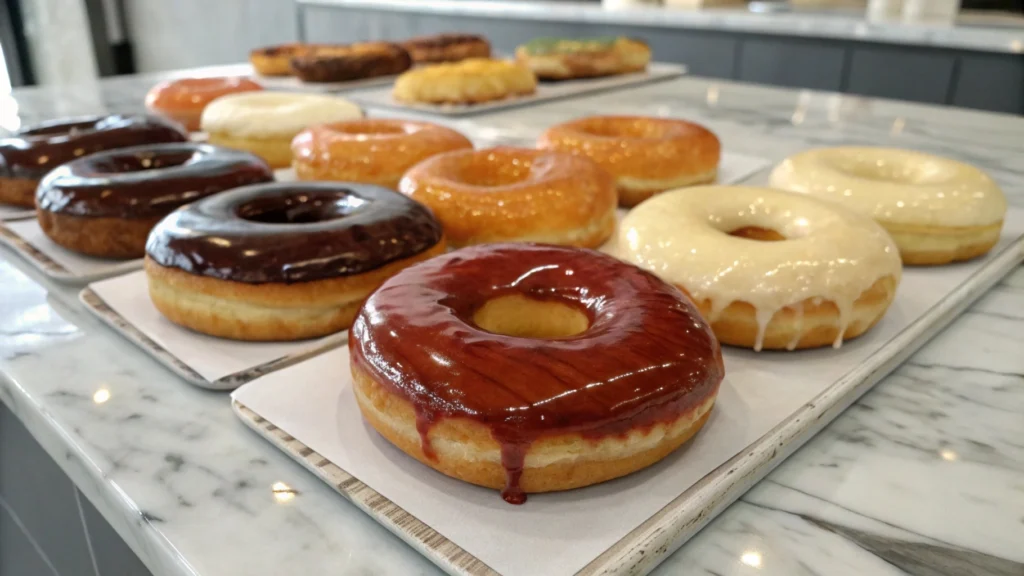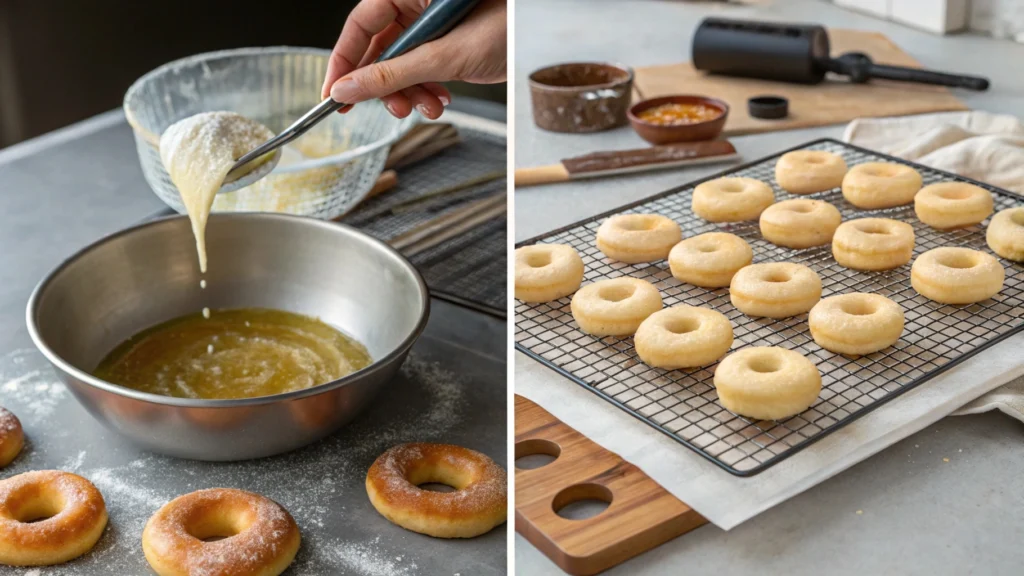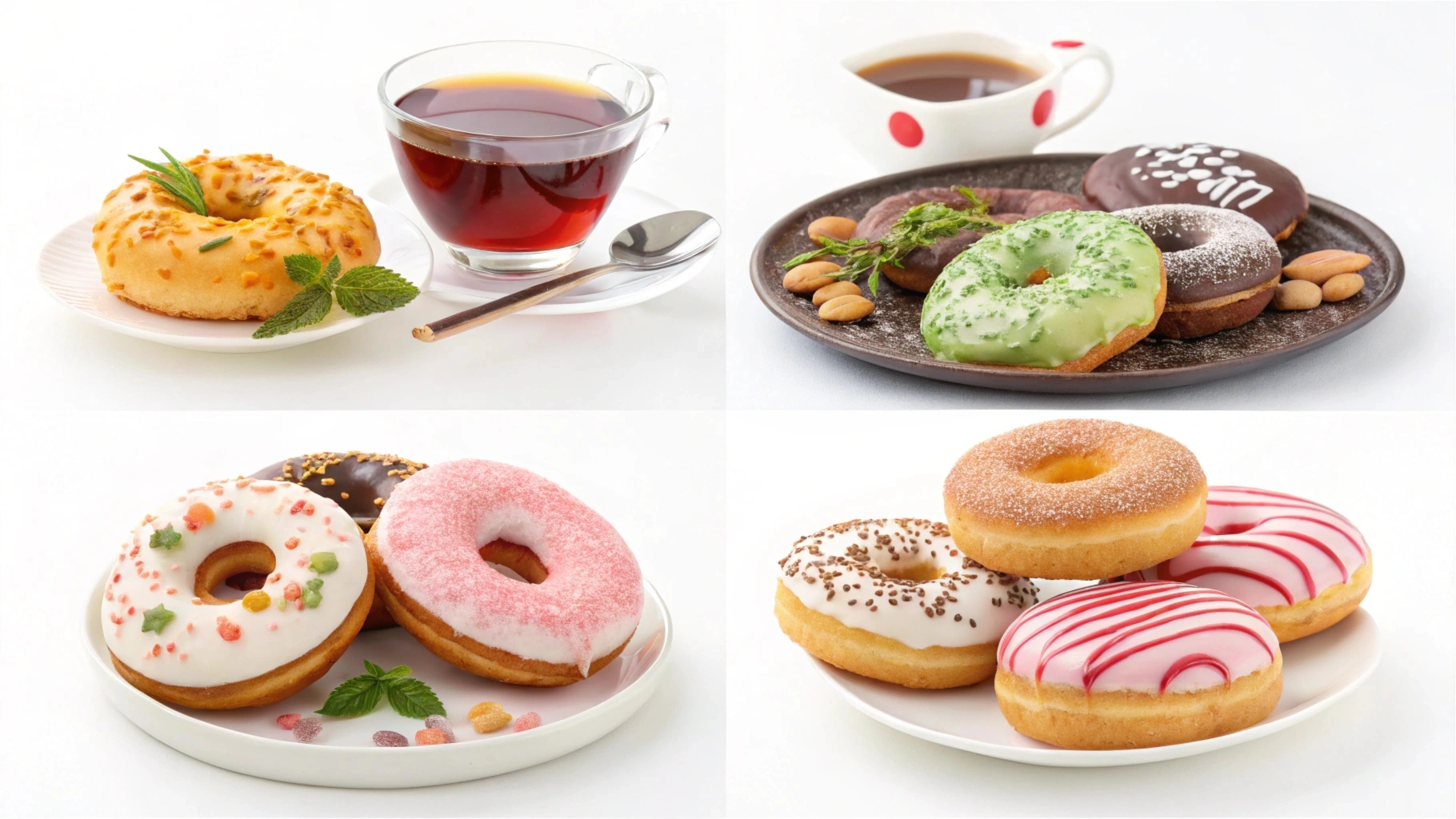Ah, the glazed donut – a simple yet irresistible treat that’s beloved by millions. Whether you’re grabbing one with your morning coffee, treating yourself after a long day, or indulging in a late-night snack, the glazed donut has a way of making life a little sweeter. But have you ever stopped to think about what makes this humble dessert so special? From its soft, pillowy dough to the glossy layer of glaze that melts in your mouth, every bite is a perfect harmony of texture and flavor.
Glazed donuts are more than just a dessert. They’re a cultural icon, a nostalgic comfort food, and a symbol of simple pleasures. They’ve been around for centuries, evolving from basic fried dough into the delightful confections we know today. With countless variations and a global fanbase, the glazed donut continues to hold its place as one of the most popular pastries in the world.
In this article, we’ll explore the world of glazed donuts in detail. We’ll look at their history, types, how they’re made, and even some fun facts you might not know. Whether you’re a casual donut lover or a die-hard aficionado, there’s something here for everyone. So grab your favorite cup of coffee and let’s dive into the delicious story of glazed donuts.
What is a Glazed Donut?
Definition and Basic Ingredients
At its core, a glazed donut is a ring of fried or baked dough coated with a thin, sugary glaze that hardens to create a shiny, slightly crunchy exterior. This quintessential donut is celebrated for its simplicity no fancy toppings or intricate designs, just a perfect balance of soft dough and sweet glaze.
The basic ingredients for a glazed donut include:
- Flour: The foundation for the dough, typically all-purpose or bread flour for the perfect texture.
- Sugar: Adds sweetness and helps create a tender crumb.
- Eggs: Provide structure and richness.
- Milk or Water: Hydrates the dough and ensures a soft texture.
- Yeast or Baking Powder: Used as leavening agents to make the donut light and airy.
- Oil or Butter: Adds moisture and richness to the dough.
The glaze itself usually consists of powdered sugar, milk, and sometimes vanilla extract for added flavor. It’s mixed to a pourable consistency and applied to the donuts while they’re still warm, ensuring it adheres evenly.
The Art of the Glaze
While the donut dough is undoubtedly important, the glaze is what transforms this treat into a true indulgence. A good glaze is smooth, glossy, and just the right thickness not so thin that it disappears, and not so thick that it overwhelms the donut. Achieving this balance requires precision and practice.
The key to a perfect glaze lies in the proportions and the timing. The glaze must be applied while the donuts are slightly warm, allowing it to set quickly. The result is a shiny coating that provides a sweet contrast to the fluffy interior.
History of Glazed Donuts
Origins of Donuts
The history of the donut stretches back centuries. Variations of fried dough have been enjoyed in different cultures, from ancient Rome to medieval Arabia. However, the modern donut as we know it today began to take shape in the Netherlands, where olykoeks (“oil cakes”) were a popular treat. These deep-fried balls of dough eventually made their way to America with Dutch settlers.
The Birth of the Glaze
The addition of glaze to donuts is believed to have originated in the 19th century. While the exact origin is unclear, it was a game-changer. The glaze not only added sweetness but also extended the shelf life of the donut by creating a protective layer. As donuts gained popularity in the early 20th century, the glazed variety quickly became a favorite.
Donuts in Popular Culture
From Homer Simpson’s iconic pink-frosted donut to the rise of gourmet donut shops, glazed donuts have cemented their place in pop culture. They’ve appeared in films, TV shows, and even as part of viral trends on social media. This widespread recognition speaks to their universal appeal.
Types of Glazed Donuts
Classic Vanilla Glaze

The classic vanilla glaze is the gold standard of donuts. Made with a simple mixture of powdered sugar, milk, and a hint of vanilla extract, it offers the perfect balance of sweetness and aroma. The glaze forms a smooth, shiny coating that complements the soft, fluffy texture of the donut. This timeless flavor has been a favorite for generations, serving as the foundation for countless variations.
Specialty Flavors
While the classic glaze holds a special place in our hearts, modern twists have elevated the glazed donut into a gourmet experience. Some popular specialty flavors include:
- Chocolate Glaze: Rich and decadent, this variation uses cocoa powder or melted chocolate in the glaze.
- Maple Glaze: With its earthy sweetness, maple glaze is a comforting favorite, often paired with bacon for a sweet-savory combination.
- Caramel Glaze: A buttery, golden option that adds a hint of sophistication to the traditional donut.
- Fruit-Flavored Glazes: Options like strawberry, blueberry, or lemon add a tangy, vibrant twist to the classic.
These specialty glazes cater to diverse tastes, offering something for everyone.
Regional Variations
Around the world, different cultures have put their unique spin on the glazed donut:
- Krispy Kreme-Style Donuts (USA): Known for their light, melt-in-your-mouth texture and ultra-thin glaze.
- Beignets (France/USA): While not traditionally glazed, some versions of these French-inspired pastries are dusted with a sugar glaze.
- Pon de Ring (Japan): A chewy, mochi-like donut with a subtle glaze, inspired by the country’s love for unique textures.
- Bomboloni (Italy): These filled donuts are sometimes finished with a light sugar glaze instead of powdered sugar.
These regional variations highlight the adaptability and global appeal of glazed donuts.
How Glazed Donuts Are MadeMaking the Perfect Dough

The foundation of a great glazed donut starts with the dough. The process involves mixing flour, yeast, sugar, eggs, milk, and butter to create a soft and pliable dough. The dough is then kneaded until smooth and allowed to rise, which gives it the light, airy texture we associate with donuts.
Key Steps in Dough Preparation:
- Mixing Ingredients: Combine dry and wet ingredients to form a uniform dough.
- Kneading: Work the dough until it’s elastic and smooth, ensuring proper gluten development.
- Proofing: Let the dough rise in a warm environment until it doubles in size. This step is crucial for creating a soft texture.
Frying vs. Baking
Traditionally, donuts are fried in hot oil, giving them their signature golden crust and soft interior. However, baking has emerged as a healthier alternative. While baked donuts are lower in fat, they lack the same crispy exterior that frying provides. The choice between frying and baking ultimately depends on personal preference.
Applying the Glaze
The final and most exciting step is glazing. Once the donuts are cooked and slightly cooled, they’re dipped into the glaze. The process involves:
- Holding the donut by its edges.
- Dipping it halfway into the glaze to ensure even coverage.
- Allowing the glaze to set on a wire rack for a glossy finish.
This step transforms a plain donut into a work of art, ready to delight taste buds.
Nutritional Aspects
Calories and Macros
Glazed donuts may be a treat for the taste buds, but they can pack a caloric punch. A standard glazed donut typically contains:
- Calories: Around 200–300, depending on size and recipe.
- Carbohydrates: 25–35 grams, mostly from sugars and refined flour.
- Fats: 10–15 grams, often due to frying.
- Proteins: 3–5 grams, primarily from eggs and milk in the dough.
While these numbers may vary, it’s clear that glazed donuts are best enjoyed in moderation as part of a balanced diet.
Healthier Alternatives
For those who want to indulge without guilt, healthier versions of glazed donuts are increasingly popular. These alternatives use:
- Baking Instead of Frying: Reduces the fat content significantly.
- Whole Wheat Flour: Adds fiber and nutrients compared to refined flour.
- Natural Sweeteners: Honey or maple syrup can replace processed sugars.
- Plant-Based Ingredients: Vegan recipes use substitutes like almond milk and coconut oil.
These options retain the sweet and satisfying essence of a glazed donut while aligning with healthier dietary goals.
Glazed Donuts in Business
Famous Donut Chains
Some of the world’s most recognizable brands owe their fame to glazed donuts. A few examples include:
- Krispy Kreme: Known for their light and airy original glazed donuts, often served warm.
- Dunkin’ Donuts: Offers a variety of glazed donut flavors and styles, catering to all preferences.
- Tim Hortons: A Canadian favorite with a distinct twist on glazed donuts.
These chains have perfected the art of mass-producing consistently delicious donuts while maintaining quality.
Local Donut Shops
Beyond the big names, local donut shops are often the heart of communities. These establishments pride themselves on small-batch production, unique recipes, and personal touches. Many local shops experiment with unconventional glazes and creative toppings, making them a haven for donut enthusiasts.
Economics of Donuts
The donut industry is a multi-billion-dollar market, driven by constant innovation and high demand. Glazed donuts, in particular, are a cornerstone product that keeps customers coming back. From large chains to mom-and-pop shops, this humble treat plays a vital role in the global food economy.
Recipes to Try at Home
Classic Glazed Donut Recipe
Making glazed donuts at home is easier than you might think. Here’s a basic recipe to get you started:
Ingredients:
- 2 cups all-purpose flour
- 1/2 cup sugar
- 1/2 cup milk
- 2 tablespoons unsalted butter
- 1 egg
- 1 teaspoon vanilla extract
- 2 teaspoons baking powder
- Oil for frying
Steps:
- Combine dry ingredients in a bowl.
- Mix wet ingredients separately, then combine with dry ingredients to form a dough.
- Roll out the dough and cut into rings.
- Heat oil and fry the donuts until golden brown.
- Dip in a simple glaze made of powdered sugar, milk, and vanilla.
Creative Variations
For those looking to spice things up, here are some fun glaze ideas:
- Coffee Glaze: Mix brewed coffee with powdered sugar for a caffeinated twist.
- Citrus Glaze: Add orange or lemon zest for a refreshing flavor.
- Spiced Glaze: Incorporate cinnamon, nutmeg, or cardamom for a warm, aromatic touch.
These recipes are perfect for weekend baking or special occasions.
Fun Facts About Glazed Donuts
World Records
Glazed donuts have inspired some astonishing world records. Here are a few notable achievements:
- Largest Donut: The world’s largest donut was a jelly-filled creation weighing over 1.7 tons, though glazed donuts have their own massive versions crafted for fun and publicity.
- Most Donuts Eaten in One Sitting: Competitive eater Joey Chestnut once devoured 55 glazed donuts in just 8 minutes!
- Longest Donut Line: In 2019, a bakery in Malaysia set the record for the longest line of donuts, stretching over 4 kilometers, many of which were glazed.
Trivia
Did you know?
- “Donut” vs. “Doughnut”: Both spellings are correct, but “donut” became popular thanks to advertising by major chains.
- National Donut Day: Celebrated annually on the first Friday of June, this holiday has its roots in honoring the Salvation Army volunteers who served donuts to soldiers during World War I.
- Iconic Glazed Donut Chains: Krispy Kreme’s “Hot Light” signals when fresh, warm donuts are ready, creating a cult-like following.
These fun tidbits add to the charm and allure of glazed donuts.
Glazed Donuts Around the World
America’s Obsession
In the United States, glazed donuts are practically a staple. From quick breakfasts to office snacks, they’re a go-to indulgence. Chains like Krispy Kreme and Dunkin’ Donuts have made glazed donuts a household name, offering them in both classic and creative varieties. Paired with coffee, they represent a quintessential American experience.
International Takes
Other countries have embraced glazed donuts with their own twists:
- Japan: Pon de Ring donuts, made with a chewy, mochi-like dough, are lightly glazed for a unique texture.
- France: While beignets are more traditional, some French bakeries experiment with glazed variations.
- India: The influence of Western bakeries has introduced glazed donuts as a trendy dessert item in urban areas.
- Middle East: Glazed donuts are gaining popularity, often served with local tea blends for a delightful pairing.
These international adaptations highlight the universal appeal of glazed donuts.
Why We Love Glazed Donuts
Nostalgia and Comfort
There’s something about biting into a freshly made glazed donut that takes us back to simpler times. For many, glazed donuts evoke memories of childhood trips to the bakery or sharing treats with friends and family. Their familiar flavor and texture offer a sense of comfort and joy.
Perfect Pairings
Glazed donuts are incredibly versatile when it comes to pairing. Here are some classic and creative options:
- Coffee: The bitterness of black coffee perfectly complements the sweetness of the glaze.
- Milk: A timeless duo, milk enhances the soft texture and sweetness of the donut.
- Ice Cream: Glazed donuts make an excellent base for an indulgent dessert, serving as a bun for ice cream sandwiches.
These pairings elevate the experience, making each bite even more enjoyable.
FAQs About Glazed Donuts
How Long Do Glazed Donuts Stay Fresh?
Glazed donuts are best enjoyed fresh, but they can stay soft and flavorful for about 1–2 days if stored properly. To keep them fresh:
- Place them in an airtight container at room temperature.
- Avoid refrigeration, which can dry out the dough.
Can Glazed Donuts Be Frozen?
Yes! Freezing glazed donuts is an excellent way to extend their shelf life. Wrap each donut in plastic wrap or aluminum foil, then place them in an airtight container or freezer bag. When ready to eat, thaw at room temperature and warm briefly in the microwave for a just-made feel.
What Makes the Glaze Stay Shiny?
The shine comes from the sugar and liquid (typically milk or water) in the glaze, which form a glossy surface as they cool and harden. Adding a touch of corn syrup can enhance the shine further.
Are Glazed Donuts Vegan?
Most traditional glazed donuts are not vegan, as they contain ingredients like eggs, milk, and butter. However, vegan recipes and options are becoming more common, using plant-based substitutes for a similar taste and texture.
What’s the Best Way to Reheat a Glazed Donut?
The microwave is the quickest option. Heat for 10–15 seconds to soften the donut and slightly warm the glaze. Alternatively, you can use a low-temperature oven for a slightly crispier exterior.
Can I Customize My Glaze?
Absolutely! You can add food coloring, sprinkles, or flavor extracts to create unique and personalized donuts. Experimenting with ingredients like fruit purees or coffee can lead to exciting results.
Why Glazed Donuts Are Timeless
The simplicity and versatility of glazed donuts keep them timeless. Whether they’re served plain or dressed up with toppings, they cater to diverse tastes.
Pro Tips for the Perfect Donuts
- Use fresh yeast for the best rise.
- Don’t over-knead the dough too much can make your donuts dense.
- Maintain oil temperature to avoid greasy or undercooked donuts.
If you’re a fan of sweet treats, you might also love this Snickerdoodle Recipe Without Cream of Tartar a unique twist on the classic cookie!
Looking for something refreshing to pair with your donuts? Try this Crème De Menthe Magic to elevate your drinks with a minty touch.
For breakfast lovers, this Aunt Jemima Pancake Mix Guide will make your mornings even more magical!
And if you love crispy, golden-brown delights, you’ll want to read Toastul: A Comprehensive Guide to the Perfect Toast.
Conclusion
The glazed donut is more than a sweet treat; it’s a universal symbol of indulgence, comfort, and joy. From its humble origins to its iconic status in modern culture, the glazed donut continues to win hearts across the globe. Whether you’re enjoying a classic vanilla glaze or exploring creative flavors, there’s no denying the timeless appeal of this delightful pastry.

